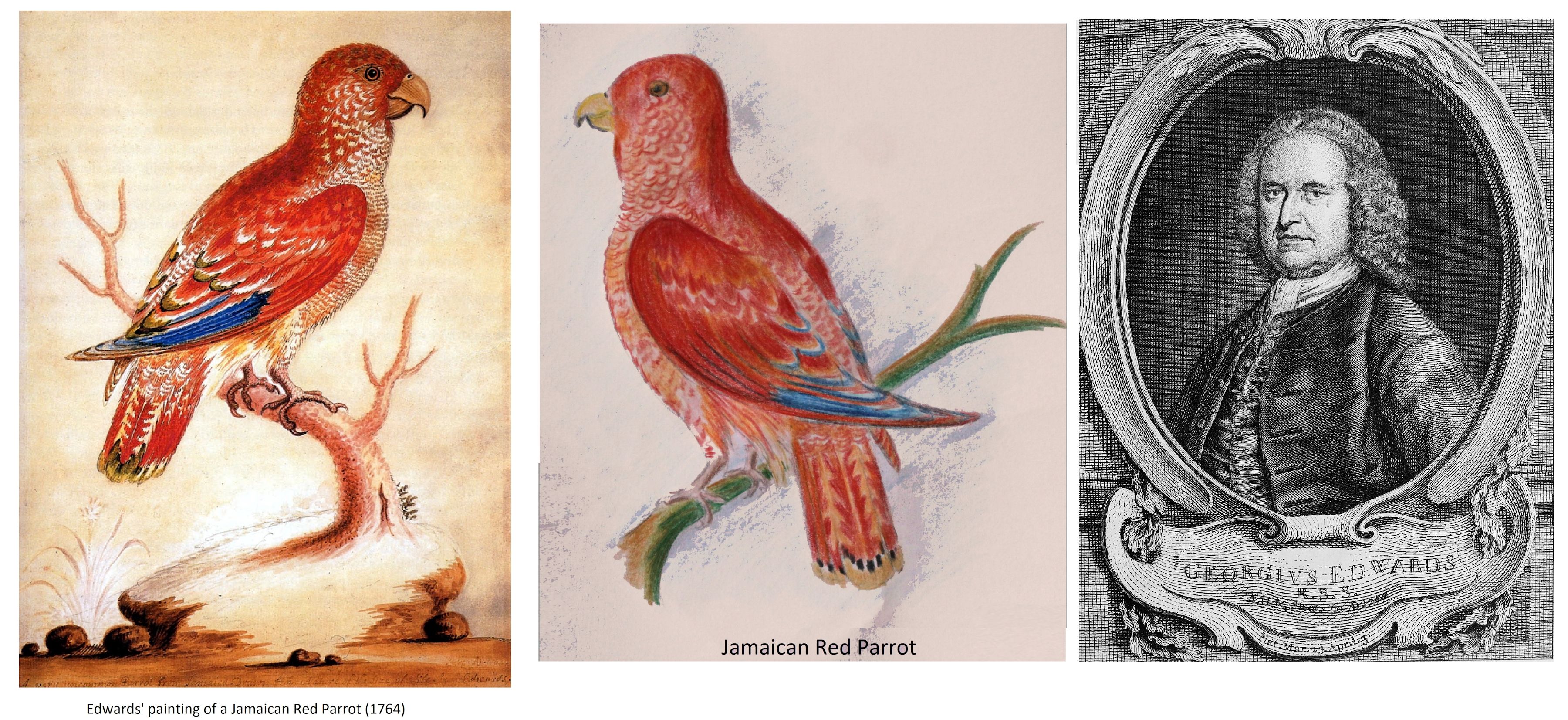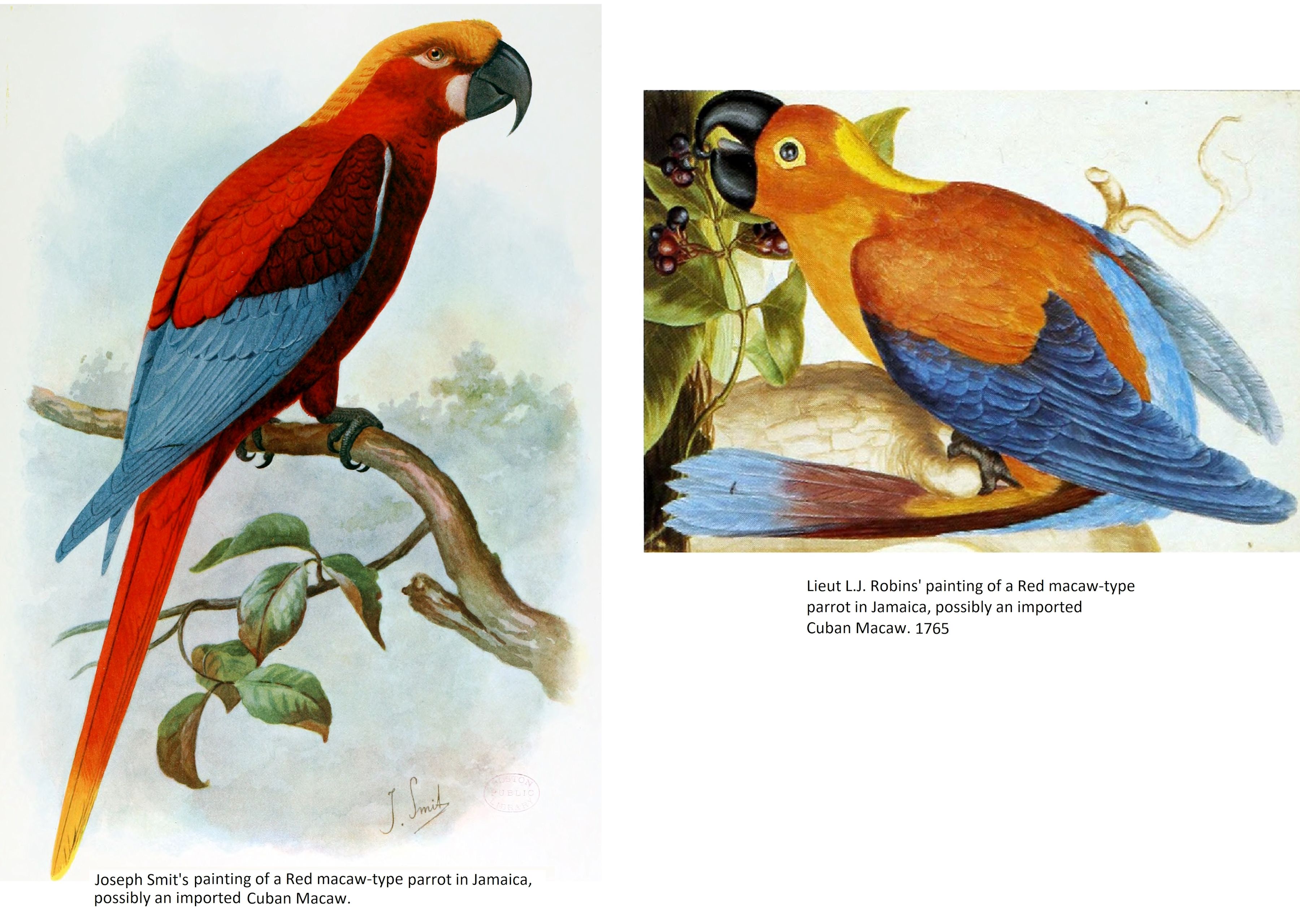
THE JAMAICAN RED PARROT AND THE JAMAICAN RED MACAW
The Jamaican Red Parrot (Edwards’ Red Parrot), which is known only from a single painting, is often conflated with the Jamaican Red Macaw (Ara gossei), a hypothetical species of parrot from Jamaica, The Jamaican Red Macaw is described and depicted with a black bill and a much longer tail than Edwards’ short-tailed, yellow-billed parrot. Amazon parrots (genus Amazona) are medium-sized, short-tailed parrots and predominantly green in colour. Macaws of the genus Ara are colourful long-tailed parrots. In both cases, because the specimen was unique and was from the West Indian Islands, where numerous parrot species became extinct, their status as either a species or as an unusual colour form of a known species is debated.
GEORGE EDWARDS’ JAMAICAN RED PARROT
George Edwards (1694-1773) was a naturalist, author and painter. He was the author and illustrator of “A Natural History of Uncommon Birds” (1743-51) and “Gleanings of Natural History” (1758-64) and was a Fellow of the Royal Society. Edwards painted a life-sized watercolour of a parrot with the inscription: “A very uncommon parrot from Jamaica. Drawn from Nature the size of life by G. Edwards, July 1764.” He included a handwritten description on the back of the painting:
“The insides of the wings and under Side of the tail is of a Durlis [possibly a fabric dye] yellow, the colours of the upper sides casting faintly through them. This bird was lent to me by Dr. Alexander Russel and is preserved in his collection. It was shot in Jamaica and brought Dryed to England. The people on Jamaica did not remember Ever to have Seen one of this species of Parrots before. - Geo. Edwards, July, 1764. Some of the fethers have their tipps red and Others have them yellow. The fethers on the under sides, Back and rump have yellow with fine transverse lines of red.”

The skin was sent to England, but its whereabouts – like the other specimens in Alexander Russell’s extensive collection - are unknown. It is most likely it deteriorated (preservation methods being poorer) and was eventually thrown away, a fate that also befell a number of dodo specimens. Based purely on the watercolour, it seems likely it was an Amazona collaria with the opaline mutation. Its dimensions, based on Edwards’ life-sized painting, fall within the ranges of other Amazona species.
Black-billed Amazon (A. agilis) – total length 225 – 245 mm; wing-length 155 – 175 mm; head-length 55 – 60 mm; bill depth 23 – 25 mm (specimens at Natural History Museum in Tring, England.)
Yellow billed Amazon (A. collaria) – total length 225 – 280 mm; wing-length 175 – 190 mm; head-length 53 – 70 mm; bill depth 26 – 28 mm (specimens at Natural History Museum in Tring, England.)
Edwards’ Red Parrot (A. edwardsii?) – total length 243 mm (9 inches); wing-length 165 mm; head-length 62 mm; bill depth 25 mm (based on life-sized painting)
Cuban Amazon (A. leucocephala) – total length 280 – 330 mm (internet)
George Edwards’ parrot resembles an Amazona parrot, a widespread genus in Central and South America as well as the West Indies. Amazona collaria (Yellow-billed Amazon) and A. agilis (Black-billed Amazon) are native to Jamaica and their dimensions have been compared to Edwards’ painting. The total length of Edwards’ Parrot is intermediate between A. agilis and A. collaria, but the wing length is shorter and the combined head and bill length is much larger than either species. The bill depth is intermediate between the two. All of this suggests that Edwards’ “life-size” rendition is not accurate in its proportions.
The Yellow-billed Amazon and Black-billed Amazon are both mainly green. Edwards’ red parrot is mainly red, but has blue wing primary feathers, as does the Yellow-billed Amazon. This suggests a mutation known as “opaline” which reduces the amount of melanin in the plumage and increases the amount of red, orange or pink psitacin. Since the Yellow-billed Amazon has reddish-pink psitacin in its plumage, Edwards’ Parrot was seems likely to be an opaline form of Yellow-billed Amazon, not a distinct species. The mottled head suggest it was a juvenile.
The Black-billed Amazon lacks red psitacin in its normal plumage coloration. The Cuban Amazon has even more reddish-pink psitacin in its plumage than the Yellow-billed Amazon, so Edwards’ red parrot could also have been an opaline form of this. Because Edwards’ Jamaican Red Parrot was apparently unknown to Jamaicans even when it was collected, it is more likely to have been an erythristic (red) colour morph of a known species rather than a species in its own right.
THE JAMAICAN RED MACAW (AKA JAMAICAN YELLOW-HEADED MACAW)
Edwards’ Jamaican Red Parrot, known only from a painting, is sometimes conflated with the Jamaican Red Macaw (Ara gosei) which was also known from a single skin and a painting. The only reported specimen of the Jamaican Red Macaw was shot on that island around 1765, and its taxidermy mount was later seen by a Dr. Robinson who sent a description of it to Philip Henry Gosse, who published his own description of it 1847: “Basal half of upper mandible black; apical half, ash coloured; lower mandible, black, tip only ash coloured; forehead, crown, and back of neck, bright yellow; sides of face, around eyes, anterior and lateral parts of the neck, and back, a fine scarlet; wing coverts and breast deep sanguine red; winglet and primaries an elegant light blue. The legs and feet are said to have been black; the tail, red and yellow intermixed.” Robinson stated that the bird had never been seen or figured before, and that it was very different from any macaw he had seen.

Joseph Smit's plate in Walter Rothschild's “Extinct Birds” (1907) is accompanied by Gosse's account of the Jamaican Macaw which has a yellow crown.
A painting by Lieut. L. J. Robins, in “The Natural History of Jamaica” (1765), depicted a long-tailed red parrot that does not exactly match the description of the Jamaican Red Macaw (A. gossei), the only known specimen of the latter having been shot near Lucea in 1765 by a Mr Odell (Gosse 1847). Robins' Red Parrot has either a yellow crest or a yellow nape, and its plumage doesn’t match that of the now-extinct Cuban Macaw (Ara tricolor).
The painting by L.J. Robbins in 1765, which was thought to depict the Jamaican Red Macaw, may have shown an imported Cuban Macaw. Nevertheless, the Jamaican Red Macaw was given its own Linnaean binomial by Sir Walter Rothschild in 1905. ("Extinct birds: An attempt to unite in one volume a short account of those birds which have become extinct in historical times: That is, within the last six or seven hundred years: To which are added a few which still exist, but are on the verge of extinction". 1907, Rothschild.)
You are visitor number